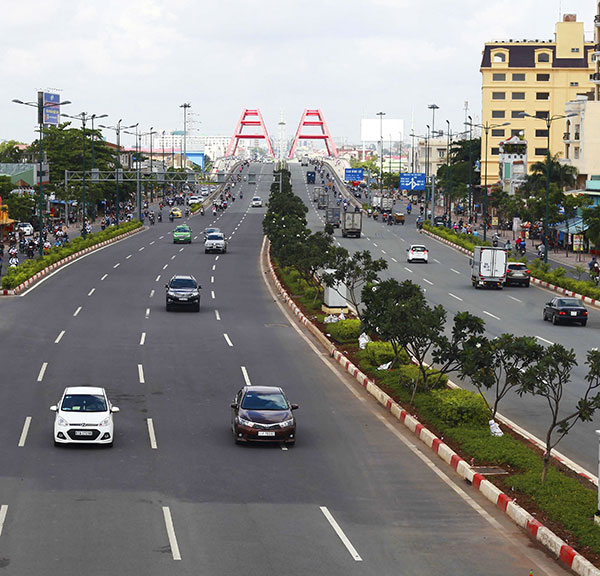Vietnam: A land of milk, honey, and concrete
 |
Much of Vietnam’s infrastructure and many of its institutions are in one way or another strained. Investment is needed everywhere. The people’s mode of thought and the whole outlook on infrastructure are encountering tremendous change. Advances in battery technology, the Paris climate agreement, the decline of coal and the rise of renewables – all have massive implications for infrastructure.
At the same time, Vietnam is becoming more reliant on private sector financing. Government debt is stated to amount to just under 65 per cent of GDP, at which the country has set the cap for 2016-2018. Yet the Ministry of Planning and Investment estimates that Vietnam needs around $170 billion to develop its infrastructure between now and 2020, including transportation, bridges, power plants, water supply networks, waste treatment plants, and ports. Public sources of capital, including the state budget, government bonds, and official development assistance can only be counted on for about half of this sum. As such, the potential need for private investment in new infrastructure alone over the next few years could approach $100 billion.
APEC companies are ideally placed to take advantage of the opportunities that will arise in myriad ways, such as:
- More opportunities to develop new or renewed infrastructure assets.
-A need for the equipment and materials that are used for such infrastructure.
-The government’s sale of existing state infrastructure assets, usually through the equity in state-owned enterprises.
-The numerous services that are needed to support each of the above.
Conventional energy
The power sector has long been the beneficiary of foreign investment. In the early 2000s it was primarily gas-based (like the Phu My 2-2 and Phu My 3 power plants). Subsequent projects were coal-fired, and largely funded by APEC members. Investors in Mong Duong 2 were from the US, South Korea, and China; those in the more recent Nghi Son 2 project were based in Japan and South Korea; Vung Ang 2 is primarily Japanese; Nam Dinh was a Korean project that added Middle Eastern investors.
The future is equally accessible to APEC investors. In light of the damage to the environment that has been caused by some projects, and the unwillingness of many institutions to lend for coal projects as a result of the Paris climate undertakings, the attention is moving towards gas and renewables. The big gas-to-power projects are the Block B/52-O Mon project, which started life as a US project and now features Japanese and Thai investors, and the Blue Whale project, which is led upstream by ExxonMobil, with various Asian power companies looking at the downstream power end.
The downstream gas distribution infrastructure is receiving attention from Japan. PetroVietnam Gas has reportedly sold 24.9 per cent of a natural gas distribution subsidiary to Tokyo Gas. In 2016, a joint venture comprised of Tokyo Gas, PetroVietnam Gas, and Bitexco established LNG Vietnam JSC, a liquefied natural gas (LNG) importer and distributor.
This is an area that is inevitably going to expand, with numerous opportunities at all points along the chain, from sales and transportation of LNG to the importation of LNG, re-gasification, on-shore distribution, and end-use – such as power plants and other industries. APEC area companies are well-placed to benefit.
The Vietnamese government is selling other parts of its energy businesses. A strategic interest in PetroVietnam Power will soon be up for sale. This was initially expected to be 49 per cent, but has recently been reduced to 29 per cent, possibly as a result of the current froth in the initial public offering market. PetroVietnam Power currently manages and operates four gas-fired power plants, three hydropower plants, and one coal-fired thermal power plant, with a capacity of 4,208 megawatts (MW). It will also invest in the Nhon Trach 3 and 4 thermal power plants and take over projects from its parent company, PetroVietnam. A number of Japanese and Singaporean companies, among others, have been expressing interest, though it is a long road from such interest to completion, and no one should underestimate the challenges of such a transaction.
Similarly, the government is attempting to determine how to sell strategic stakes in the electricity generating companies owned by Electricity of Vietnam (EVN). There are several Gencos. The first to be equitised was supposed to be Genco3, but this has proved difficult, partly because Genco3 owned coal-fired plants as well as hydropower plants, which killed its appeal, and partly because of the poor quality of the power purchase agreements which underlie its revenue stream.
Another avenue for businesses interested in the construction of the infrastructure sector is to invest in the large Vietnamese construction companies that are in the process of equitisation. Song Da Corporation, one of the largest, is due to equitise in 2019 and set to sell 30 per cent to a strategic investor.
 |
| To support the economic future that Vietnam is aiming for, infrastructural boosts are needed in many areas Photo: Le Toan |
Renewable energy
Vietnam’s overworked planners believe that solar power generation capacity will increase from around an imperceptible 7 MW in mid-2016 to a massive 12 gigawatts (GW) by 2030. This has spawned a storm of activity in the wind and solar business. In September, Circular 16 confirmed a relatively generous feed-in tariff (FiT) for solar power of 9.35 US cents per kilowatt-hour (kWh) for grid-connected solar. This FiT applies for 20 years to projects that reach commercial operation before June 30, 2019. Interested APEC investors with identified projects may now be justified in hurrying them forward. Similarly, any residual electricity generated by rooftop solar arrays will be purchased by EVN at the same FiT for a 20-year term, provided that the project reaches commercial operation before June 30, 2019. A slight catch is that there is no provision for indexation of the FiT by way of escalation to address inflation risks, so an FiT that looks good today may not look the same tomorrow.
Wind projects have continued to stall because the FiT of 7.8 US cents/kWh on offer has generally been regarded as uneconomic. The Ministry of Industry and Trade recently issued a draft circular proposing an increase of the FiT for onshore wind projects to 8.77 US cents/kWh and for offshore to 9.97 US cents/kWh.
The opportunities for APEC investors lie not only in the projects themselves, equipment suppliers can also benefit. GE makes wind turbine generators and control systems at a plant in Vietnam. First Solar has resumed its solar panel manufacturing project in the country and numerous others are positioned to enter the market.
Transport
Transport used to be creaky, but has now become more or less stationary – at least during the chaos of rush hour. So roads, ports, airports, metro lines, and possibly parts of the railway infrastructure itself (a longstanding no-go area for investors) would welcome APEC interest with alacrity and, one would hope, sincerity.
Ports
The ports sector has been volatile. Some of the private sector port projects in the south have not operated as successfully as originally expected, casting a pall over lenders’ perceptions of viability. But the north has fared better. The Lach Huyen deepwater seaport near Haiphong has been a classic Japanese public-private partnership (PPP). It is spawning derivative infrastructure such as the Deep C port being considered by the continually-dynamic developers of the nearby Dinh Vu Industrial Zone.
As with the power sector, the equitisation of one of the leading Vietnamese port operators, Vinalines, is pending, with investors able to buy a strategic stake. The meaning of the word strategic in this context needs to be explored with appreciable diligence.
Airports
Historically, private investment in the airport sector was evanescent, partly the result of dual civilian and military use of many airports. The position is now changing rapidly. Private investors built the international terminal in Danang and are doing the same in Cam Ranh. The big prizes remain undeclared, such as new terminals in Ho Chi Minh City and Hanoi as well as a brand new VND300 trillion (about $15 billion) airport at Long Thanh. All still await an official government decision – and, in the case of the new Long Thanh airport, a decision by the National Assembly. This is a somewhat high-risk area for investors, as government policy on airport development remains to be determined. The logic of having one airport operator in the country – the historical model when Airports Corporation of Vietnam ran all the airports – is fighting not only a “one airport – one operator” model, which would allow different operators for different airports, but also a free-for-all, where any number of operators could operate different terminals at the same airport.
Roads and railways
The road and rail sectors are fraught with land-related issues and toll collection/franchise difficulties. There have been few successful projects to date by foreigners, but the railways are now under modern and capable leadership and commercial thinking is changing swiftly. PPP-based support, if it becomes practical, may still take appreciable time. If the model becomes bankable, however, it has the potential to create many opportunities, especially for contractor-investors.
PPP
Underlying the opportunities for APEC in Vietnamese infrastructure is the progress being made with the PPP framework. The government has worked tirelessly for years to pass and implement PPP regulations, and the results are beginning to blossom.
The government is focusing resources to deliver a few bankable flagship projects to prove the feasibility of this scheme. When there are records of success, the authorised state bodies and investors will be motivated to follow the PPP path. In this context, several things will of course be important to APEC investors:
lA robust and consistent risk allocation framework applying across industries, which provides a level of certainty on key risks that should be retained by the government so that infrastructure PPP projects can be successfully delivered with minimum transaction costs incurred by investors.
lResolution of outstanding implementation issues, such as the statutory restriction on mortgaging land-use rights to foreign lenders; complex regulatory approvals and processes for land acquisition and compensation; uncertainty in the applicability of foreign laws in contracts where all parties are Vietnamese nationals; and the payment ability and creditworthiness of an SOE offtaker.
lDifferent sectors will require different viability gap funding regimes. The government will, in due course, issue guidance on the support and a viability gap funding regime in each infrastructure sector. This will make it easier for the authorised state bodies and the investors to align on the agenda, objectives, and timing for the development and financing of projects.
What the stars mean:
★ Poor ★ ★ Promising ★★★ Good ★★★★ Very good ★★★★★ Exceptional
Latest News
More News
- APEC week boosts Vietnam’s appeal (November 12, 2017 | 17:56)
- APEC minister vow to boost co-operation (November 11, 2017 | 14:00)
- Japanese firms sign $5-billion raft of deals with Vietnam (November 10, 2017 | 11:00)
- First VBS kicked off in Danang (November 07, 2017 | 17:10)
- Ford’s continuing efforts to make Vietnam’s roads safer (November 07, 2017 | 16:08)
- Viet Nam is trying to improve itself: PM (November 07, 2017 | 15:34)
- PM delivers keynote speech at Viet Nam Business Summit (November 07, 2017 | 11:34)
- APEC Vietnam 2017 special publication now available (November 07, 2017 | 11:32)
- Four Vietnamese entrepreneurs to attend APEC CEO Summit (November 06, 2017 | 20:38)
- State President: APEC shows strong vitality and resilience despite global upheavals (November 06, 2017 | 20:24)










 Mobile Version
Mobile Version